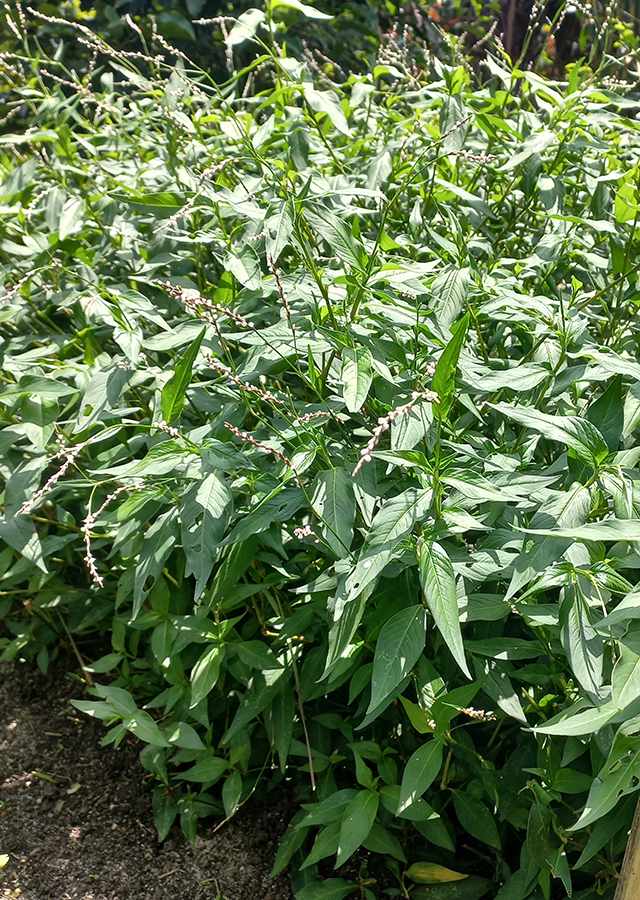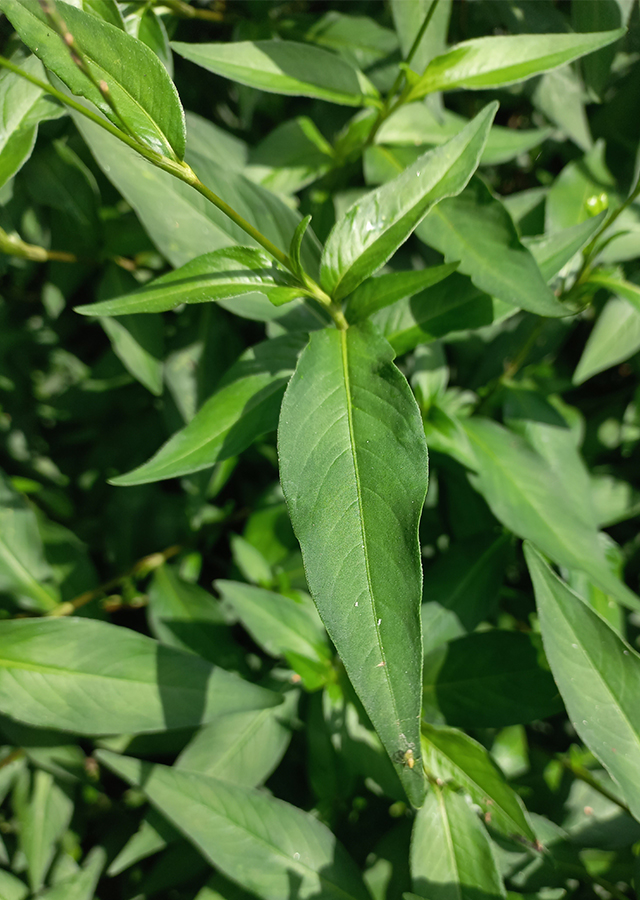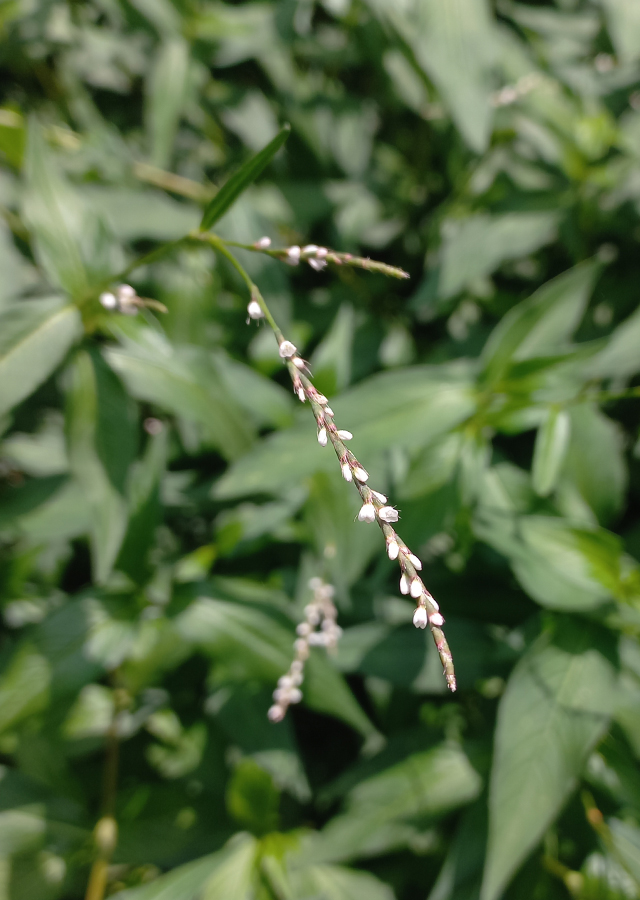Traditional Herbs from Persicaria hydropiper
toothache
- Prepare enough water for pepper leaves, wash them thoroughly.
- Crush them until they become a paste.
- Put the leaf paste on the sore tooth.
treat_menstrual_pain
- Take enough water to wash pepper leaves. until clean.
- Blender with a little water.
- Strain and drink to treat menstrual pain.
What is Persicaria hydropiper Looks like??



Parts of Persicaria hydropiper that could be used
- Leaves
- Roots
- All Parts of the Plant
Persicaria hydropiper Distribution
Water pepper or Persicaria hydropiper is a common weed plant from the Polygonaceae family. This species has been distributed worldwide and is found native to temperate and tropical Asia including West Asia, the Caucasus, Siberia, Central Asia, the Russian Far East, China, East Asia, the Indian Subcontinent, Indo-China, and Malesia; European regions such as Northern Europe, Central Europe, Eastern Europe, Southeastern Europe and Southwest Europe; as well as North Africa and Australia. Water pepper has a strong spicy taste and is generally used as a hot spice (pepper substitute), food flavoring, and also used as a garnish for various traditional dishes (such as Japan, Southeast Asia, China and Malaysia). This species also produces leaves that can be consumed (especially in Japan), either eaten directly (raw) or cooked. Water pepper is also highly valued for its function as a medicinal plant and has a long history of herbal use, in both Eastern and Western herbalism. It is appreciated mainly for its astringent properties which are useful in treating bleeding, skin problems, diarrhea, etc. In China, this species was ranked 20th in a survey of 250 potential antifertility drugs. Apart from that, the water pepper plant also has various other benefits, including as a source of dye (yellow) for traditional fabrics, an insect repellent to protect clothes, and fish poison.Agroecology of Persicaria hydropiper
Water pepper is a widely distributed plant, found growing from cold climate zones to tropical areas. Often found growing in open wet places, poorly drained agricultural land, old rice fields, along rivers, riverbanks, swamps, poorly drained basins, from sea level to a height of 1,500 m above sea level. Grows in shallow water, wet or moist soil. This species likes sunny locations and does not like shade. Grows well in most soils including silt, peat, clay and sand. Although this plant can tolerate a wide range of pH, water pepper generally grows better in more acidic situations.
Morphology of Persicaria hydropiper
- Taproot, tufted or short creeping.
- Stem erect, much branched, usually branched towards the tip. Rooted from the lower nodes, the nodes are swollen, green to red or light brown, and above each node is surrounded by Cylindrical membrane ocreas 0.5-1 cm long with a hairy tip. The surface of the stem is smooth and hairless or glabrous.
- Single leaves, arranged alternately (alternate), have short stalks that taper into long, smooth glandular blades. 4-10 cm.\u00a0The emerging leaves are rolled down at the edges. Modified stipules known as ochreae stem sheath above the junction of the stem and petiole. the tip of the leaf is sharp (acute) to tapered (acuminate), the edge of the leaf is small hairy (ciliated).
- Flowers have a greenish proximal and distal The perianth is white or pink, tepals obovate, 6-8 stamens, and 2-3 pistils (style). The inflorescences are erect, occurring at the tips of all branches and in the axils of the upper leaves. Each is a slender (often nodding) spike of green to pink flowers externally covered with dark glands.
- Achene fruit, 2-3 sided, 2-3 mm long, blackish brown that remains enclosed within the dried flower .
Cultivation of Persicaria hydropiper
Plant propagation is mainly through seeds, but can also be through broken stems (where the stem can root at the nodes and grow into a new plant).
Persicaria hydropiper, more details :
Chemical Content of Persicaria hydropiperPolygonic acid, tannins, essential oils, malic acid, phytosterin, oxymethyl-anthraquinone, alkaloid compounds, flavonoids (catechin, epicatechin, hyperin, isoquercitrin, isorhamnetin, kaempferol, quercetin, quercitrin, rhamnazin, routine), saponins, terpenoids, steroids, one new drimane type sesquiterpenoids (3 β-angeloyloxy-7-epifutronolide), polygonumate, six known drimane-type sesquiterpenes (dendocarbin L, (+) winterin, (+) fuegin, changweikangic acid A, futronolide, and 7-ketoisodrimenin), phenylpropanoid esters (including hydropiperosides A and B, and vanicosides A, B, E), phenolic acids (caffeic acid, chlorogenic acid and �-coumaric acid).
Benefits of Persicaria hydropiper
Stops bleeding and treats wounds, skin problems (itching, scabies, ringworm, boils), diarrhea, dysentery, dyspepsia, ulcers, headaches, menstrual pain, excessive menstrual bleeding, uterine disorders, regulates menstrual irregularities, lung problems, bleeding uterus, treating diabetes, insomnia, depression (sedatives) and neurodegenerative diseases, rheumatism, gout, overcoming swelling and inflammation, snake and dog bites, loss of appetite, problems dandruff, fighting cancer, controlling fertility, termination of pregnancy (if consumed continuously causes permanent infertility), poultice and medicine for toothache. It acts as a carminative, diuretic, stimulant, anthelmintic, emmenagogue, antioxidant, antibacterial, anti-inflammatory and anticancer.
Simplisia of Persicaria hydropiper
- Prepare the pepper roots with enough fresh water, wash thoroughly with running water.
- Dry in the sun or in an oven at a temperature\u00a040\u00b0C until the water content\u00a010%.
- Clean it using a blender until it becomes powder.", "Store in a clean and airtight container.
Another Facts for Persicaria hydropiper :
Synonym of Persicaria hydropiperPersicaria acris Gray, Peutalis hydropiper (L.) Raf., Polygonum hydropiper L.
Habitus of Persicaria hydropiper
Herb. Erect, annual herb, plant height around 40-70 cm
Habitat of Persicaria hydropiper
- Wetland
- Riverside
No comments:
Post a Comment